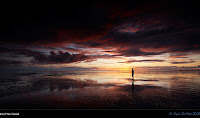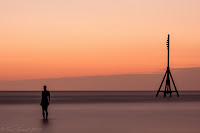My final assignment for Location photography was a Self- directed brief. I was required to produce some more independent work based on my preferred subject matter. So now, I'm going to discuss and show you some of my recently captured images. A few weeks ago, when the weather was perfect to fill up my boots and do some location photography, I went down to Crosby beach in the mid afternoon. To take images on location is always a challenge because you have to manipulate and take control of the lighting,backgrounds, etc. I knew that Crosby is one of the photographers favorite place and there I can take different types of images, for example !!!Documentary,Landscape and Nature!!!
So when I got there, I really tried to apply all my knowledge and skills that I've learned so far on the course, during my first academic year at St Helens College. Here I'm mainly thinking about compositions,
like triangular/circular, rule of third, framing, repetition, etc or the formal elements, like color, line, shape, tone, etc. Also, I did a recap on depth of field because that's always has an impact on the composition, so I looked through my old notes and refreshed my memory about how I can make images that's got either shallow or wide depth of field. Additionally, when I did my primary research in the library, I found a book - Techniques of Natural Light Photography by Jim Zuckerman - that helped me to choose the right time of day for my shooting. Jim Zuckerman shows how you can take great pictures morning, noon and nearly night - outdoors and in - with natural light. The golden hours are known as the best time to shoot. The golden hours are usually an hour after sunrise and an hour before sunset. During these hours I can get the benefit of the perfect light.
Right, I arrived in Crosby around 3 o'clock and I used the mid-afternoon and late-afternoon hours to shot some Documentary and Nature images.
Documentary: (All images are edited into sepia and I pumped up the contrast,shade and the saturation. Also, the sepia helps you to see the tonal balance of the image.)
Image No. 1
Compositions:
* Rule of thirds
* Negative space.
* Wide depth of field.
* Off center weighted.
* Shot from directly above.
* Repetition of the footprint.
* Triangular composition between the 3 white pebbles.
* Triangular composition between the 3 white pebbles.
Formal Elements:
* Shape of the footprints.
* Texture of sand.
* Tonal balance.
Image No. 2
Compositions:
* Rule of thirds.
* Bottom weighted.
* Shot in a low angle.
* Slight shallow depth of field.
* Side lit gives more texture.
* Implied lines draw your eyes.
* Captured movement gives dynamic to the image.
Formal Elements:
* Tonal balance.
* Texture of sand and subjects.
* Diagonal lines - the lean of hands, legs, horizon.
Image No. 3
Compositions:
*Rule of thirds.
* Bottom weighted.
* Slight shallow depth of field.
* Captured movement gives dynamic to the image.
* Repetition of the houses at the background.
Formal Elements:
* Tonal balance.
* Diagonal lines lead your eyes.
* Texture of sand and dog's hair
Image No. 4
Compositions:
* Rule of thirds.
* Implied line.
* Wide depth of field.
* Reflection in the water.
* Repetition of the houses at the top.
* Captured movement gives dynamic to the image.
Formal Elements:
* Tonal balance.
* Texture of sand.
* Diagonal lines create dynamic and horizontal line.
Image No. 5
Compositions:
* Rule of thirds.
* Bottom weighted.
* Reflection on the water.
* Wide depth of filed.
* Freezing movement.
Formal Elements:
* Tonal balance.
* Horizontal and diagonal lines.
Image No. 6
Compositions:
* Rule of thirds.
* Wide depth of field.
* The reflection on the water form a triangle.
* Captured movement gives dynamic to the image.
Formal Elements:
* Tonal balance.
* Texture of sand.
* Horizontal lines.
Nature: (All images are edited. I pumped up the contrast, shade and the saturation.) The late afternoon hours offers many of the same characteristics as sunrise. During these hours you can see the effect of the warm and low-angled light on a variety of subjects and that how it creates texture. Also you will get more texture and longer shadows if you side lit the subject.
Image No. 7
Compositions:
* Rule of thirds.
* Off center weighted.
* Repetition of stones.
* Slight shallow depth of field.
* The light gives a soft and warm effect.
* Side lit therefore it gives more texture.
Formal Elements:
* Texture of stones and moss.
* Natural colors (brown,gray)
* Secondary colors (orange,green)
* Primary color (red)
Image No. 8
Compositions:
* Rule of thirds.
* Negative space.
* Off center weighted.
* Shallow depth of field.
* Side lit therefore it gives more texture.
* The light gives a soft and warm effect.
Formal elements:
* Tonal balance.
* Texture of sand and shell.
Landscape: Just to know what Environmental photography is: It is about capturing the essence of a landscape. Considering the elements of your surroundings in the outdoor world.
Alright, so to capture my landscape images I was waiting till sunset because no other time of the day offers such a wonderful opportunities to capture a classic sunset shot. The brilliant colors of the sky, the long shadows, pronounced textures and the golden hues dramatize landscape,wildlife, portrait, etc.
First of all I want to show you the dramatic difference between sunset lighting and late afternoon light in these two shots below. Because the colors and the quality of the natural light changes dramatically throughout the day. I also uploaded the unedited images of the examples. (All images are edited and I pumped up the contrast,shade and the saturation.)
 |
| Ex.1: Unedited - Late afternoon light |
 |
| Ex. 1: Edited - Late afternoon light |
 |
| Ex. 2: Edited - Sunset light |
 |
| Ex. 2: Unedited - Sunset light |
Image No. 9
Compositions:
* Rule of thirds.
* Wide depth of field.
* Off center weighted.
* Repetition of the windmills.
* Reflection of the golden sunlight.
* Scaling between the two iron man
Formal Elements:
* Horizontal line.
Image No. 10
Compositions:
* Rule of thirds.
* Wide depth of field.
* Off center weighted.
* Reflection of the golden sunlight.
* Scaling between the two iron man
Formal Elements:
* Texture of sand.
* Horizontal line.
Image No. 11
Compositions:
* Rule of thirds.
* Wide depth of field.
* Repetition of the windmills and birds.
* Reflection of the golden sunlight.
Formal Elements:
* Horizontal line.
* Texture of sand.
And finally but not least ... my favorite one ... :)
Image No. 12
Compositions:
* Framing.
* Rule of thirds.
* Off center weighted.
* Slight negative space.
* Shallow depth of field.
* Reflection of the golden sunlight.
Formal Elements:
* Horizontal lines.
* Texture of sand and iron man.
Image No. 12 is my favorite because the framing makes the image special and interesting. It looks like an image in an image. You're looking at the hole image first,then you're looking through the gap. Also, I love the halo around the sun and the little iron man in the distance. These little details make the image more interesting.
(All of the above photos taken by Fanni Horvath using a Canon EOS 1100D.)
I'd like to go back to Crosby one time, because I really loved shooting there. So, next time when I get there, I'd like to try out some new things. So just to see how can I improve my work in the future I did a small amount of research on professional photographers' work. Which can be also good to compare my work and other's work. I found two types of examples that really caught my eyes. On the first two images, you can see that how the photographers used the puddles/the still water to reflect the sky. On both image the bisector is in the middle and also those brilliant colors of the sky, the shadows, the reflection on the water or the pronounced textures are all dramatize the whole feeling of the image. While the last two examples are completely the other end. The feeling of the images are so relaxed and peaceful, mainly because the colors are pale and the sky is clear. Also, I love the effect of the water, how the photographers made it so smooth and silky.

My opinion about what kind of equipments could be used to produce these images is that I think the photographers used a wide angle lens or a medium length lens, tripod, lens hood, filters. (A tripod is definitely used on the last two examples.) I said wide lens (14 mm - 35 mm) because the wide angle lens is traditionally the go-to lens for landscape photographers. So like on the top right image, the suspected wide lens allowed the photographer to capture a very wide shot. Perhaps for the 3 other examples, the photographer used a medium length lens (40 mm - 150 mm) which is a great lens for capturing landscapes as your naked eye sees them. The camera settings were probably a slow shutter speed and high f-stop so they could get a wide depth of field and the silky water effect on the last two. Finally the ISO is around 100-200.

So next time I will be really looking for those puddles and hopefully I will find some interesting reflection in it. Also, I will have a go to get that silky water effect. And if I'll correctly read the weather and light conditions then I'll know which type of image I should attempt on that day. Lastly, I want to buy some new props too for next time, like filters and lens hood because some of the most stunning landscapes are shot during sunrise and sunset and this often puts the sun in a direct line of sight with the lens causing nasty lens flare. However I quite like the lens flare now on my images.














No comments:
Post a Comment